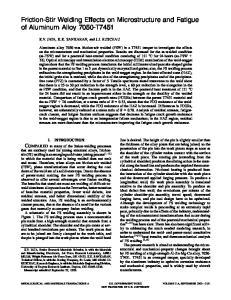Processing, Microstructure, and Residual Stress Effects on Strength and Fatigue Crack Growth Properties in Friction Stir
- PDF / 1,345,159 Bytes
- 16 Pages / 593.972 x 792 pts Page_size
- 87 Downloads / 344 Views
UCTION
FRICTION stir welding (FSW) is a solid-state joining process invented by The Welding Institute in 1991. This process is capable of producing high quality welds in both similar and dissimilar metals, including many alloys deemed unsuitable for conventional fusion welding, such as some magnesium and aluminum alloys.[1] In addition, this process results in lower temperatures, and therefore reduced thermal gradients within the weld zone compared to many fusion welding techniques. This is an important consideration for welding alloys in an age-hardened state because degradation of peak mechanical properties is a function of maximum weld temperature.[1–3] The FSW process uses a non-consumable cylindrical or conical tool to provide both the frictional heating and the stirring action required to join the metals. Figure 1 schematically illustrates the FSW process. During welding, the tool is plunged into a rigidly clamped workpiece while rotating, and traverses the weld seam at a constant velocity. As the tool travels, frictional heat is created through the contact friction between the shoulder and the workpiece, and due to the resulting plastic deformation of the material in the stir zone (SZ). The high strain and heat energies experienced by the base metal during stirring causes dynamic recrystallization, which is the formation of new grains in the weld zone.[3] ANDREW L. BIRO and BRENDAN F. CHENELLE, Graduate Students, and DIANA A. LADOS, Associate Professor, are with the Integrative Materials Design Center, Worcester Polytechnic Institute, 100 Institute Road, Worcester, MA 01609. Contact email: andrew. [email protected] Manuscript submitted January 6, 2012. Article published online September 6, 2012. 1622—VOLUME 43B, DECEMBER 2012
Friction stir weld microstructures consist of four distinct zones. The dynamically recrystallized zone (DXZ or nugget) is a region consisting of very fine, equiaxed grains that were subjected to the high strain and thermal energies from the weld pin. Just beyond the nugget is the thermo-mechanically affected zone (TMAZ), which is a zone unique to FSW. The grains in TMAZ are highly elongated as a result of high strain forces from the rotating pin, but do not experience enough thermal energy for recrystallization to occur. Next to the TMAZ is the heat affected zone (HAZ), which is common to most welding operations. The size of this zone is dependent on the heat input into the weld, which is a function of the processing parameters. Plastic deformation does not occur in the HAZ.[1] Beyond the HAZ is the parent material, which was relatively unaffected by either thermal or strain energies from welding. A typical FSW microstructure can be seen in Figure 2. The FSW process also introduces residual stresses into the material, like any other welding or joining technology. The benefit of FSW is that it is able to easily generate compressive residual stresses on the surface of the weld, thereby improving properties of the weld, specifically related to fatigue crack initiation and growth. Processing parameter
Data Loading...











